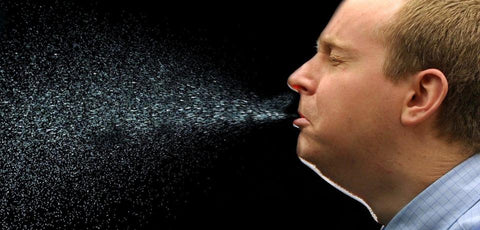THE DANGER YOU CANNOT SEE
You can see dirty water and rotten food. That's why you don't drink or eat it. But you cannot see the dangerous particles in the air. That’s why you breath it.
POLLUTION AND SMOG
According to World Health Organization (WHO), air pollution is the single largest environmental health risk we face. The concentration of particulate matter (PM) in the air, especially the chemicals and other substances in it, can be harmful, even deadly.
Eyes water, throats get sore, people cough. Smog can make people ill and sick people even sicker. It irritates the eyes, the throat, the lungs and blurs our vision. Particles with a diameter of 10µm (micrometers) or less (PM10) can penetrate deep inside the lungs, whereas fine particles with a diameter of 2.5µm or less (PM2.5) can go even further into the blood stream and spread to other organs.
Air pollution can lead to serious health damages. It has been linked to eczema, asthma, emphysema, cardiovascular difficulties, and lung and stomach cancer.
However, smog has even a harmful effect on the environment - food crops and animals suffer.
That's why it should be the mission of all of us to do everything possible to reduce human-made atmospheric pollutants and smog.

POLLEN AND ALLERGENS
Some plants, including ragweed, grasses, and oak trees, create a fine powder called pollen that’s light enough to travel through the air.
Depending on the saison, the spread of pollen in the air means misery for allergic people: In spring some of them are allergic to tree pollen, whereas during summertime others have a problem with grass pollen. And still others have trouble with weed pollen, which is common in fall.
If allergic persons go outside their body will react as if it’s being invaded. The immune system will make a lot of something called histamine to fight back and their body will develope clinical symptoms like:
- itchy throat
- red, itchy, watery eyes
- runny or stuffy nose
- sneezing
- wheezing or coughing
This can even lead to chronic health problems, e.g. bronchial asthma.
And of course, also animal allergens can be spread from one environment to another, both in the air and through direct contact with animals.
And even allergies to pets with fur are common, especially among people who have other allergies or asthma. In the United States, as many as three in 10 people with allergies have allergic reactions to cats and dogs.
In cats, for example, the cleaning behaviour causes the spread of allergens, because it brings the smallest scales to the outside of the coat and further into the ambient air. Salivary proteins stick to the coat itself and these protein molecules are bound to the house dust and can remain in the apartment for months.
So it is not just the hair itself that poses an allergy risk, but also saliva, body secretions and skin scales.

BACTERIA, GERMS AND VIRUSES
Bacteria and viruses differ significantly, e.g. already in size. Bacteria have a diameter of up to one micrometer and are thus on average up to one hundred times larger than viruses, which can be 20 to 300nm (nanometers) in size.
Viruses are so small that they can be present in the air that infected people breathe out. Influenza viruses can be up to 120nm in size, corona viruses up to 160nm.
The rhinovirus, for example, which is responsible for most colds, measures only 20nm. A one-euro coin would have room on it for enough cold viruses to infect the entire world population. So in the end, 50 million people are infected with cold viruses every day.
Bacteria and viruses get really easy into the air. Whether you are traveling by air, train, bicycle, or simply walking, you are exposed to various types of bacteria in the air.
When breathing, each person emits tiny droplets of a size of one micrometer; each breath can contain 1,000 to 50,000 droplets. When coughing, the droplets are ten times larger at over ten micrometers.
And imagine what happens, if someone is sneezing or coughing. Tiny water or mucous droplets filled with bacteria and viruses scatter into the air, causing disease and/or making a condition even worse.
According to a study by the Massachusetts Institute of Technology (MIT), the smallest droplets can fly up to 40 metres when sneezing. And when coughing, flow velocities of up to 1,000 KM/H can occur.

